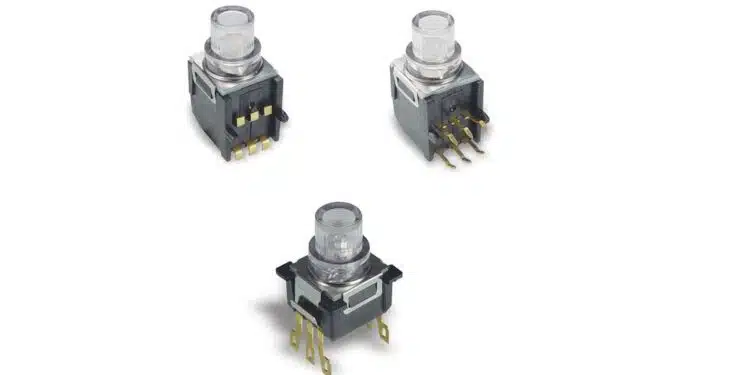Littelfuse launches first reflow-compatible illuminated tactile switch with SPDT and long travel. The New K5V Series switches combine LED backlighting, gold-plated reliability, and compact, dust-resistant design—now with high-temperature PAR material for streamlined SMT assembly.
Littelfuse, Inc., an industrial technology manufacturing company empowering a sustainable, connected, and safer world, announced the expansion of its K5V Series illuminated Tactile Switch family with the release of new K5V4 models.
These include the Gull Wing (GH) and 2.1 mm Pin-in-Paste (PIP) versions, which are compatible with reflow soldering. (View the video in English, Chinese, Japanese.)
Built using a high-temperature PAR (polyarylate) material with a 250°C thermal deformation threshold, the new K5V4 switches are ideally suited for manufacturers transitioning from wave to reflow soldering processes. By eliminating the need for silicone sleeves or special handling and enabling direct SMT assembly for the first time, they reduce production costs, support increased throughput, and improve end-product quality – all while maintaining durability and tactile performance.
“These new K5V4 switches are designed to meet the demands of today’s dense electronic systems, where space efficiency, reliability, and user interface feedback are critical,” said Jeremy Hebras, VP, Switches & Sensors Engineering at Littelfuse.
“The K5V switch product series has been created to answer unique customer device architectures where the main board and components are positioned at a 90° angle to the front panel. In combination with long travel, sharp tactile feel, and backlighting, the K5V is ideal when accurate device control is needed—especially where unwanted actuation or lack of immediate user feedback is not acceptable.”
Features
- Reflow soldering-compatible via PAR material—no sleeve required
- SPDT contact configuration with normally open and normally closed options
- Sharp tactile response with audible click and 4N operating force
- Integrated high-brightness LEDs in multiple colors and bi-color options
- Compact, dust-resistant design for reliable operation in dense boards
- Gold-plated dome contacts for superior long-term contact performance
- Available in SMT (GH) and THT (PIP) versions for design flexibility
Application
- Data centers and servers: System control and diagnostic interface buttons
- Network infrastructure: Reset and feedback switches for routers and telecom devices
- Industrial equipment: Control panel interfaces, safety reset points, and signal input
- Pro audio/video systems: Tactile response for mixers, switchboards, and low-light interfaces
By delivering the first long-travel, SPDT, illuminated tactile switch in a reflow-capable SMT package, Littelfuse fills a critical gap in the market. Competing solutions often require wave soldering, which adds complexity and cost to the assembly process. The K5V4 Series combines superior ergonomics, visual feedback, and manufacturability in a compact, robust solution.
This expansion reinforces the Littelfuse commitment to advancing tactile switch technology and supporting OEMs with high-performance human-machine interface (HMI) components optimized for modern production environments.






























